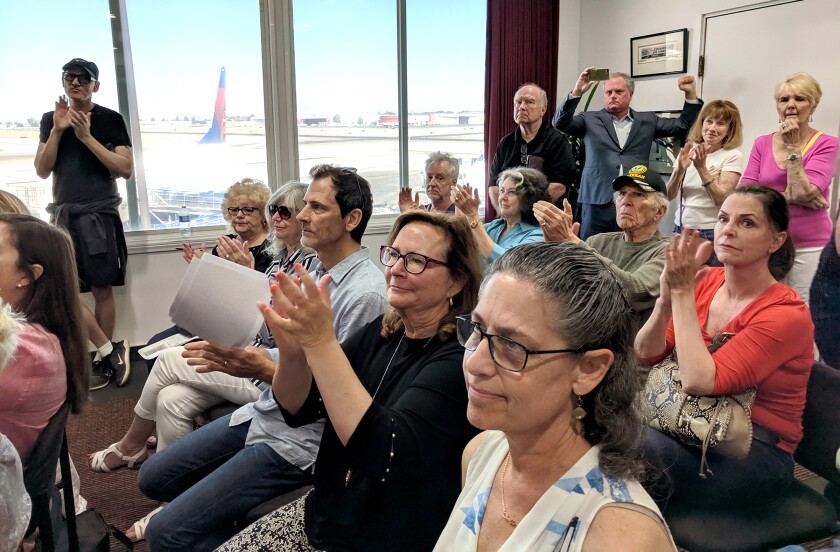When federal regulators first warned operators of the Hollywood Burbank Airport that the terminal was located too close to the runways, a gallon of regular gasoline cost $1.19, leg warmers were all the rage and “Star Wars: The Empire Strikes Back” was one of the top grossing movies in theaters.
Nearly 40 years later, the Federal Aviation Administration has completed an environmental study that would normally signal the final step before construction can begin on a replacement for the airport’s cramped 90-year-old facility.
But after decades of setbacks, legal disputes and neighborhood opposition, the quest to build a modern terminal that meets federal safety requirements may be delayed again by the pandemic, which has pushed demand for air travel to record lows.
“I can’t imagine a project with a more solid footing than this,” said Patrick Lammerding, the airport’s deputy executive director of planning and development. “The wildcard is COVID.”
The next step in the process is a 45-day public review of the environmental impact statement, which analyzes traffic, air pollution, noise and other effects of the project. The review period began last week.
But how to pay for the $1.2-billion project is still up in the air because the pandemic has severely reduced airport revenue, making it difficult for the airport to turn to a traditional bond measure for the financing, Lammerding said.
How much an airport can raise toward paying off a construction bond is based on how much revenue is generated by a passenger facility charge — a fee charged to each ticketed flyer. But the pandemic has squashed demand for air travel nationwide, with Hollywood Burbank Airport reporting an 81% drop in passengers in June, compared to June 2019.
Instead of starting construction next year, Lammerding said, the pandemic has put the construction start date in limbo.
The public has until Oct. 5 to comment on the draft environmental impact statement on the a new 355,000-square-foot terminal with 14 gates , a 413,000-square-foot aircraft parking apron and a five-to-seven story parking structure that can hold up to 6,600 cars.
Virtual public hearings on the new terminal are scheduled for Sept. 23 and 24. People who want to speak during the hearings must register online.
The new facility would be located in the northwest region of the airport, in what was once Lockheed-Martin’s B-6 plant.
The existing terminal is 232,000 square feet with 14 gates and in some places is located 313 feet from a runway, less than half the 750 feet required by current safety regulations. Federal officials began discussing the need to replace the terminal in January 1980. Parts of the existing building date back to 1930, before modern seismic safety rules were adopted.
Bob Hope and actress Jayne Mansfield prepare to leave from Burbank’s Lockheed Air Terminal in 1957 for USO shows overseas.
(Steve Fontanini / Los Angeles Times)
Since opening in 1930, the airport near the intersection of North Hollywood Way and Empire Avenue has brandished many names, including Union Airport, Lockheed Air Terminal, the Burbank-Glendale-Pasadena Airport and Bob Hope Airport, for the comedian and actor who lived in nearby Toluca Lake.
The airport was rebranded as the Hollywood Burbank Airport in 2016 to help remind out-of-town travelers of its proximity to Los Angeles.
The effort to replace the 90-year-old terminal has been delayed repeatedly by land sales at the airport, litigation involving the city of Burbank and the requirement that Burbank voters must first approve building a new terminal. A ballot measure to green light a new terminal passed with about 70% of the vote in 2016.
Throughout the debate over building a new terminal, some neighborhood groups spoke out against the new facility, arguing that it would lead to more flights, more road traffic, more aircraft noise and more pollution. The new terminal won’t increase the number of gates but will be about 53% bigger.
A group called Studio City for Quiet Skies has railed against the project for years and has sponsored a Change.org petition opposing the new terminal. The petition has collected more than 2,500 signatures.
Airport critics who have signed the petition object primarily to new flight patterns that have increased noise over nearby Studio City. They vow to oppose the new terminal until the flight patterns are changed.
“Until the departure jet path over our communities moves back to the historical flight path, we will actively oppose the replacement terminal,” the petition says.
A representative of the group could not be reached.
Alan Dymond, president of the Studio City Residents Assn., said he is not opposed to building a new terminal to meet safety requirements. He said the proposed terminal has nothing to do with the increasing airport noise problem.
“We understand that people are conflating the new terminal with the real issue, which is the noise from the airport,” he said. “They are trying to link the two together.”

Residents voiced their noise concerns to the Burbank-Glendale-Pasadena Airport Authority in July 2019.
(Anthony Clark Carpio / Burbank Leader)
Critics of the airport have blamed the new departure patterns on the FAA’s new NextGen system, a satellite-based navigation program that is designed to replace an aging radar-based system to improve flight time, fuel efficiency and safety.
The FAA has acknowledged that in recent years more flights have been departing Hollywood Burbank Airport and turning further south over Studio City and Sherman Oaks, but the agency said the NextGen system that was implemented in 2017 was not to blame. The FAA officials say the new satellite navigation points are too far from the airport to influence the direction of the takeoffs.
















